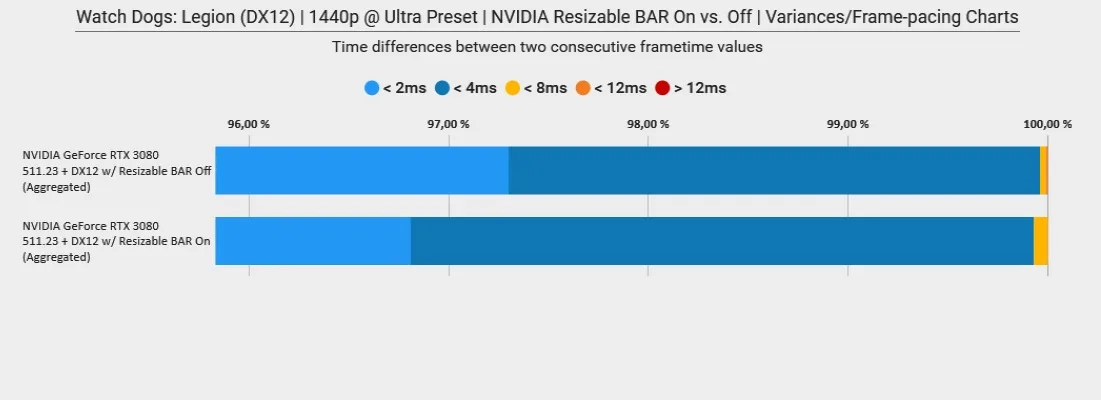NVIDIA Resizable BAR Performance Analysis (On vs. Off) – 9 supported games benchmarked, using an RTX 3080, a Z690 motherboard, and an i9-12900K CPU
A year ago, we analyzed NVIDIA Resizable BAR performance on an unsupported Intel Z390 CPU platform, so now we will test this feature on an officially supported Z690/12900K platform to see if it’s worth it. We benchmark this feature, on versus off, using our latest recommended GeForce driver, the latest version of Windows 11, and nine NVIDIA white-listed PC games which are part of our testing suite.
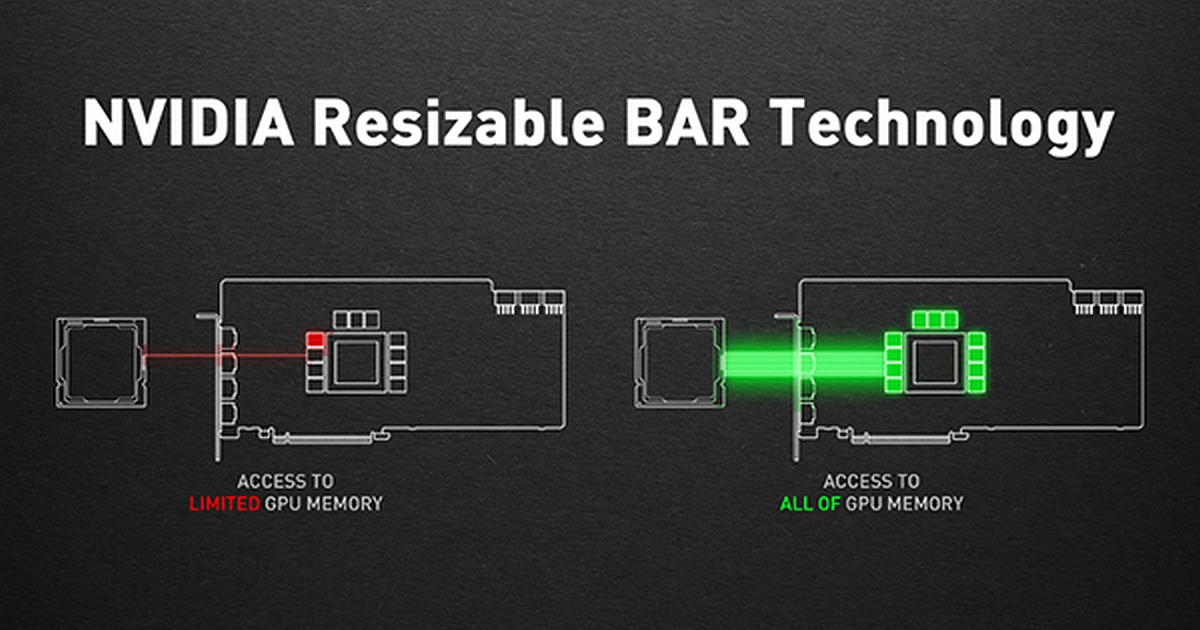
Notes on NVIDIA Resizable BAR
To use NVIDIA Resizable BAR, users need a GeForce RTX 30 Series graphics card with a supported VBIOS, a compatible CPU, a compatible motherboard and SBIOS, and GeForce 465.89 driver onwards. With these requirements met, you need to enable Resizable BAR in your motherboard’s UEFI setup program and boot your PC in UEFI mode with CSM disabled for UEFI GOP support.
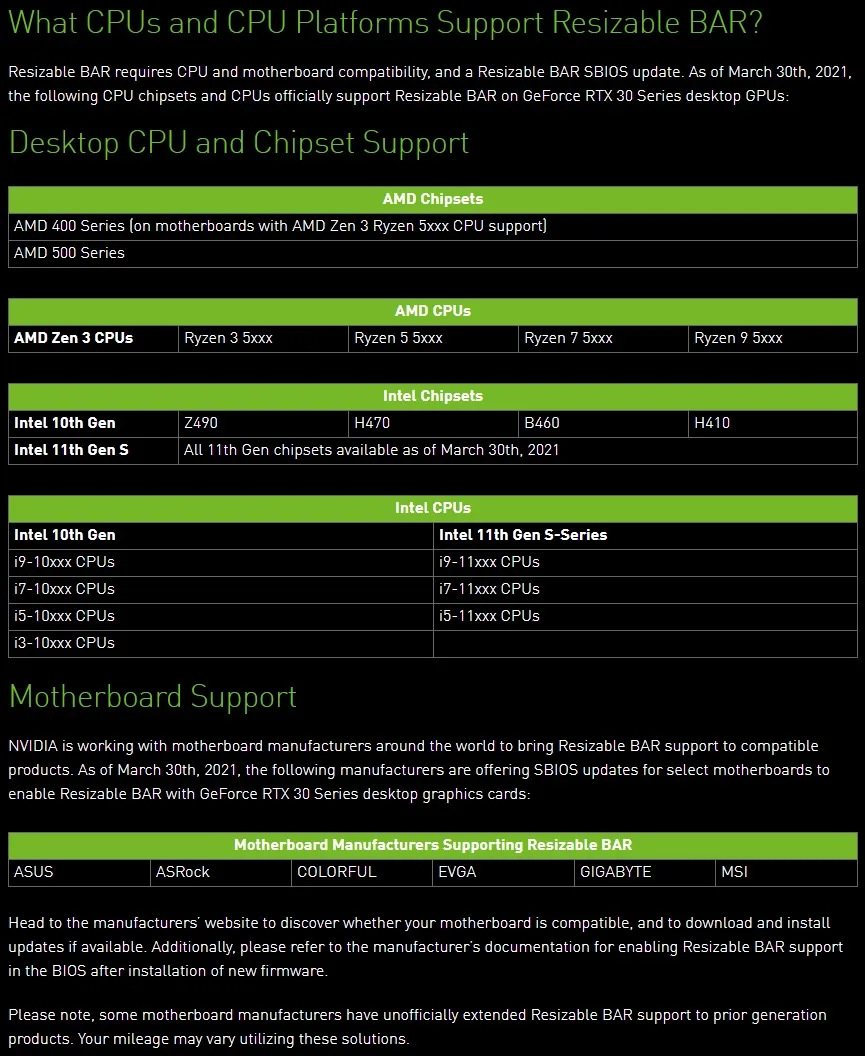
While the list above doesn’t specifically mention our Z690 platform, we asked NVIDIA directly, and they confirmed it officially supports Resizable BAR. So in this review, we will see how the following NVIDIA’s words apply to our Z690 platform or similar officially supported configurations:
” … NVIDIA will be pre-testing titles and using game profiles to enable Resizable BAR only when it has a positive performance impact. That way you won’t have to worry about bugs or performance decreases, and won’t have to rely on the community to benchmark each title and discover whether Resizable BAR is beneficial in the games you’re playing.” (Source)
How To Check the NVIDIA Resizable BAR Feature State
You can check if Resizable BAR is enabled using GPU-Z, the NVIDIA Control Panel, and Windows Device Manager. Below you can see what our testing system reports when Resizable BAR is enabled using the mentioned methods:

Our testing platform is a recent install of Windows 11 64-bit Pro Edition, an i9-12900K with stock clocks, an ASUS PRIME Z690-P D4 motherboard, and 32GB of T-FORCE XTREEM ARGB WHITE DDR4 3600MHz. The games tested, settings, hardware, GeForce drivers, and Windows 11 build are identical except for the off versus on ‘Resizable BAR’ state we compare. We enabled and disabled Resizable BAR using the UEFI setup program for our testing.
Before offering the performance data and charts of each different analysis scenario, it’s important to describe both the hardware and software configuration used in our testing, as well as the analysis methodology.
Benching Methodology
Test Configuration – Hardware
- 12th Gen Intel Core i9-12900K (Hyper-Threading/Turbo boost on; stock settings)
- ASUS PRIME Z690-P D4 motherboard (Intel Z690 chipset, v.1008 BIOS)
- T-FORCE XTREEM ARGB WHITE 32GB DDR4 (2×16GB, dual-channel at 3600 MHz CL14 XMP), supplied by TeamGroup
- Gigabyte AORUS GeForce RTX 3080 MASTER 10GB (rev. 1.0); v.F4 VBIOS, stock clocks
- 1 x Samsung 500GB SSD 960 EVO NVMe M.2
- 2 x WD Blue 1TB SATA SSD
- 1 x TeamGroup MP33 M.2 PCIe 1TB SSD
- Corsair RM850x, 850W 80PLUS Gold power supply unit
- MSI MAG Series CORELIQUID C280, ARGB CPU Liquid Cooler (AIO) 280mm CPU water cooler
- ASUS ROG Swift PG279Q 27? IPS QuadHD (2560 x 1440) 165Hz 4ms G-Sync Monitor
Test Configuration – Software
- NVIDIA GeForce 511.23 drivers; ‘High Quality’ and ‘prefer maximum performance’ (on a per-game profile-basis); Shader Cache Size ‘Unlimited’ (globally); fixed refresh rate (globally).
- V-Sync application controlled in the control panel, V-Sync off in-game.
- AA and AF as noted in games; all in-game settings are specified.
- Windows 11 64-bit Pro edition, latest updates v21H2, High-performance power plan, HAGS off, Game Mode, Game DVR & Game Bar features off, Control Flow Guard (CFG) off on a per-game basis.
- We do not install GIGABYTE and ASUS tools.
- Latest DirectX
- All 9 games we tested are patched to their latest versions at the time of publication.
- CapFrameX (CX), the latest version
- RivaTuner Statistics Server (RTSS), the latest version
- ISLC (Purge Standby List) before each benchmark.
- TechPowerUp GPU-Z (GPU-Z), the latest version
- Nvidia Profile Inspector (by Orbmu2K), the latest version
GeForce Driver Suite-related
- We use DCH Game Ready drivers.
- The display driver is installed.
- We install the latest version of PhysX.
Game Benchmarks-related
- The corresponding built-in benchmark sequence is used.
Frametimes Capture & Analysis tool-related
- We use CapFrameX for capturing and analyzing the relevant performance numbers obtained from each recorded built-in or custom benchmark sequence.
- Consecutive runs until detecting 3 valid runs (no outliers) that can be aggregated by CapFrameX using the following method:
- ‘Aggregate excluding outliers’:
- Outlier metric: Third, P0.2 (0.2% FPS percentile).
- Outlier percentage: 3% (the % the FPS of an entry can differ from the median of all entries before counting as an outlier).
- ‘Aggregate excluding outliers’:
- We compare and value the results and aggregated records in terms of percentages of gain/loss, by setting the following thresholds to consider a certain % value as significant (not within the margin of error) for our benchmarking purposes:
- Score/FPS Avg > 3% when valuing hybrid and non-synthetic benchmarks;
- FPS Avg > 3% when evaluating raw performance;
- P1/P0.2 > 3% when evaluating frame time consistency; after applying our custom formula
{[(LowPercentileFPS_2 / AvgFPS_2) / (LowPercentileFPS_1 / AvgFPS_1)] – 1} x 100
Benchmark Suite: 9 PC Games With NVIDIA Resizable BAR Support

As of today, and as shown by the Nvidia Profile Inspector tool using the latest GeForce Game Ready driver (v512.15), the total number of compatible games is 20, adding the following games to the original list:
-
- Deathloop
- Metro Exodus Enhanced Edition
- The Riftbreaker
From the above list, we benchmark the following NVIDIA white-listed games that are already part of our current testing bed (nine games):
- Assassin’s Creed Valhalla (DX12)
- Borderlands 3 (DX11 & DX12)
- Cyberpunk 2077 (DX12)
- DIRT 5 (DX12)
- Hitman 3 (DX12)
- Horizon Zero Dawn (DX12)
- Metro Exodus (DX12)
- Metro Exodus PC Enhanced Edition (DX12)
- Watch Dogs: Legion (DX12)
NVIDIA Control Panel settings
Here are the global NVIDIA Control Panel settings:
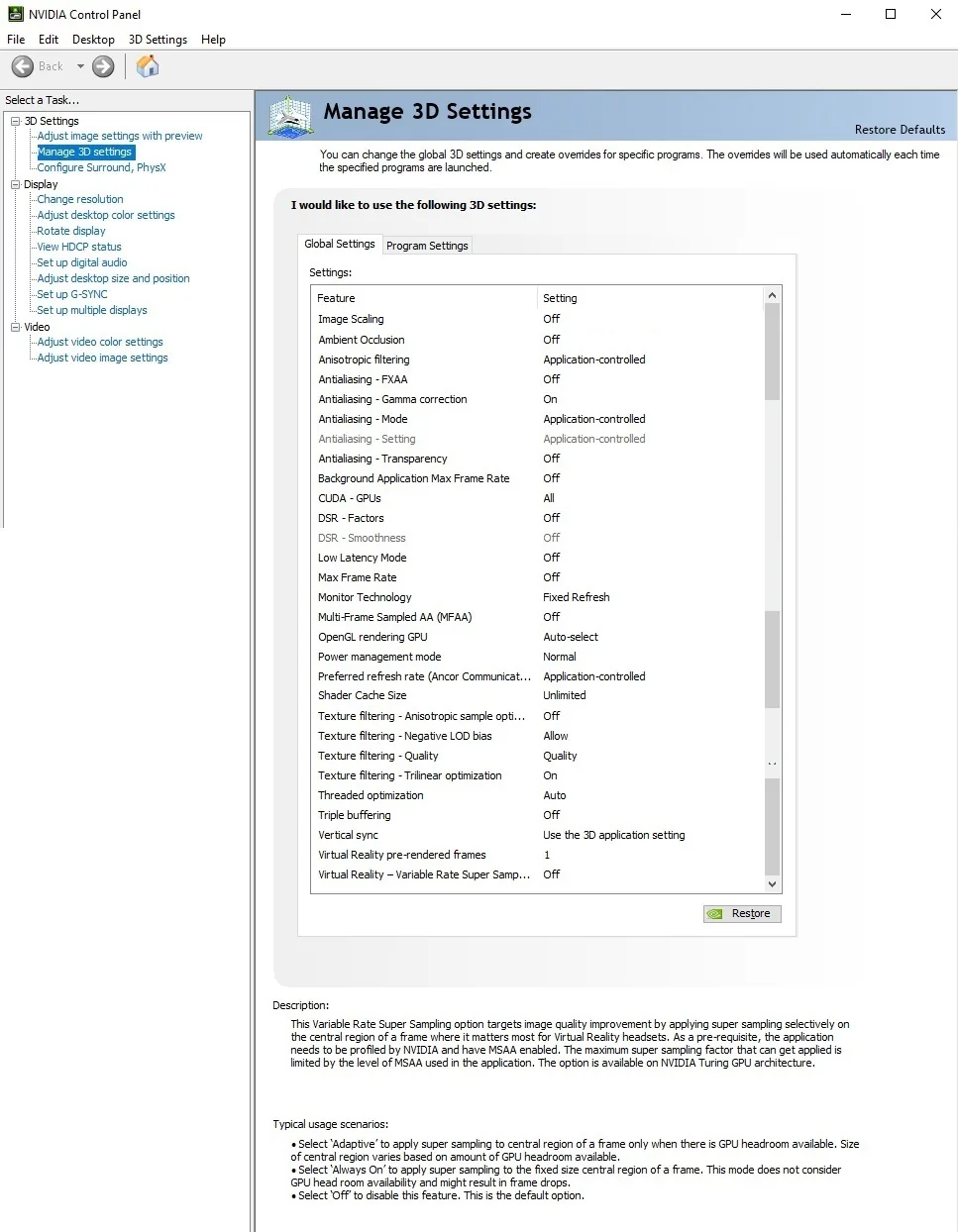
Both ‘High-Quality’ values for texture filtering-quality setting and ‘Prefer maximum performance’ for power management mode are set on a per-game or program profile basis via Manage 3D Settings > Program settings tab.
Let’s head to our gaming performance results.
The Performance Charts with 9 Games with NVIDIA Resizable BAR Support
Below you can find the summary charts of nine games whitelisted by NVIDIA with Resizable BAR support (as of March 30, 2022) that are part of our usual testing bed. We compare the games’ performance changes with ‘Resizable BAR’ enabled and disabled, using the AORUS RTX 3080 MASTER on an Intel Z690 platform.
You can see the list of games’ graphics settings on the charts, and we run each built-in game benchmark’s sequence at 2560×1440. You may click on each chart to open a pop-up for the best viewing.
Results give average framerates and higher is better. We display the low FPS percentiles (P1 and P0.2) below the corresponding averages. We use CapFrameX to record frametimes over time and to visualize and convert them into their corresponding average FPS and P1 and P0.2 FPS percentiles values.
There are also columns showing percentages of gain/loss in both raw performance (average FPS) and, when applicable, in frametimes consistency or stability between the different testing scenarios. We applied the following custom formula to calculate the stability gains or losses:
{[(LowPercentileFPS_2 / AvgFPS_2) / (LowPercentileFPS_1 / AvgFPS_1)] – 1} x 100
We mark significant performance changes (higher than 3%) in bold and use purple for the significant improvements or orange font for regressions.
NVIDIA Resizable BAR Performance Charts – On vs. Off
Assassin’s Creed Valhalla (DX12)


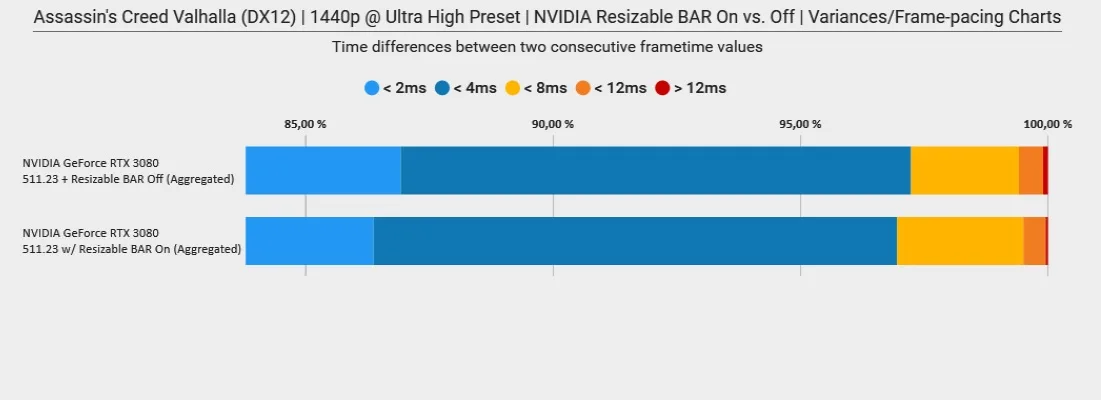 From the charts, we see a noteworthy improvement in raw performance (average FPS) with NVIDIA Resizable BAR enabled in Assassin’s Creed Valhalla (DX12). Frametime stability and frame-pacing are similar, though.
From the charts, we see a noteworthy improvement in raw performance (average FPS) with NVIDIA Resizable BAR enabled in Assassin’s Creed Valhalla (DX12). Frametime stability and frame-pacing are similar, though.
Borderlands 3 (DX11 & DX12)
DirectX 11 API

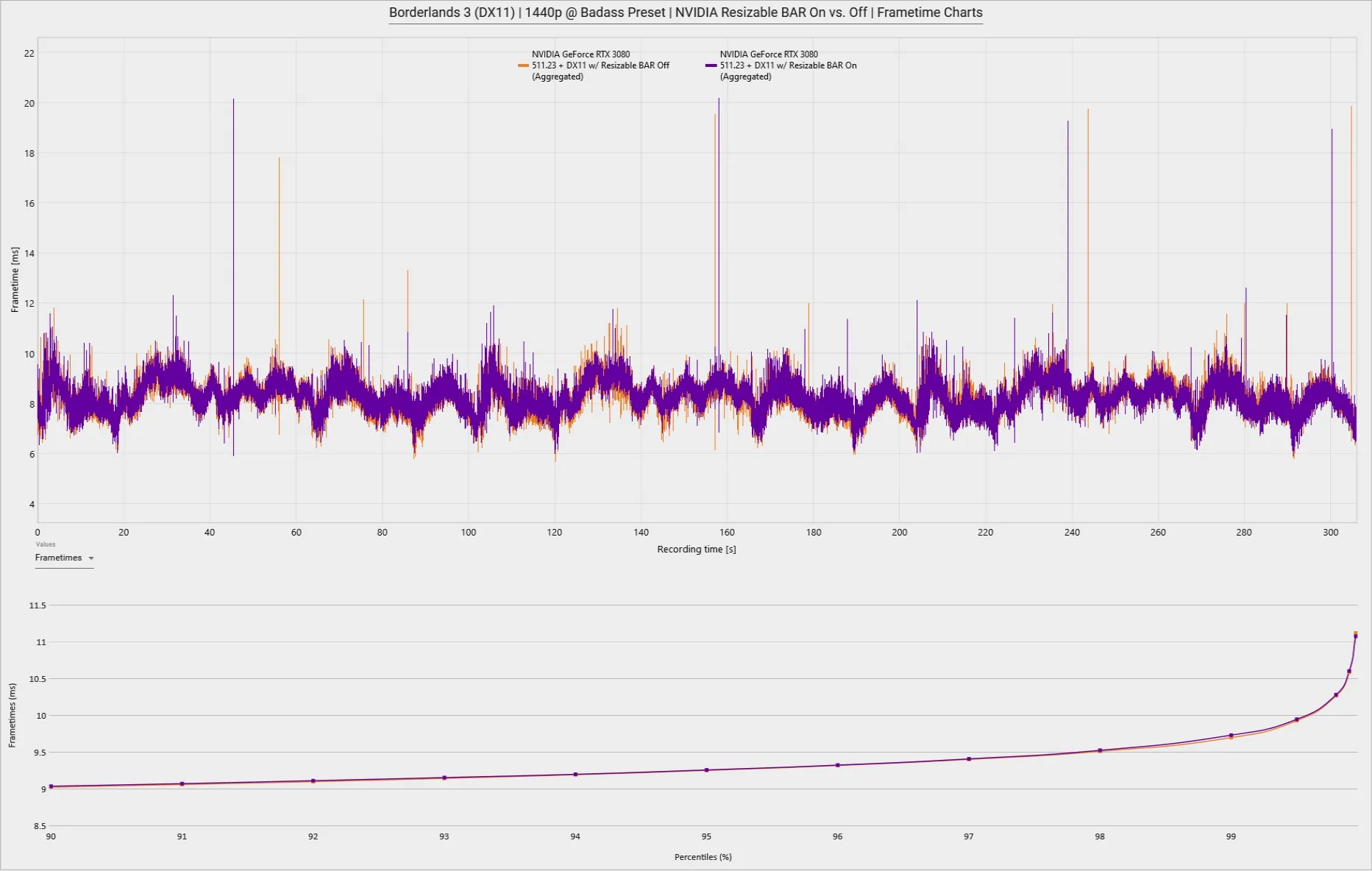
 Here we see a tie between both testing scenarios. In other words, Borderlands (DX11) shows roughly the same raw performance, frametime consistency, and frame-pacing with NVIDIA Resizable BAR enabled or disabled.
Here we see a tie between both testing scenarios. In other words, Borderlands (DX11) shows roughly the same raw performance, frametime consistency, and frame-pacing with NVIDIA Resizable BAR enabled or disabled.
DirectX 12 API


 Although the average FPS was slightly higher with NVIDIA Resizable BAR enabled in Borderlands 3 (DX12), we see overall the same performance with NVIDIA Resizable enabled or disabled.
Although the average FPS was slightly higher with NVIDIA Resizable BAR enabled in Borderlands 3 (DX12), we see overall the same performance with NVIDIA Resizable enabled or disabled.
Cyberpunk 2077 (DX12)


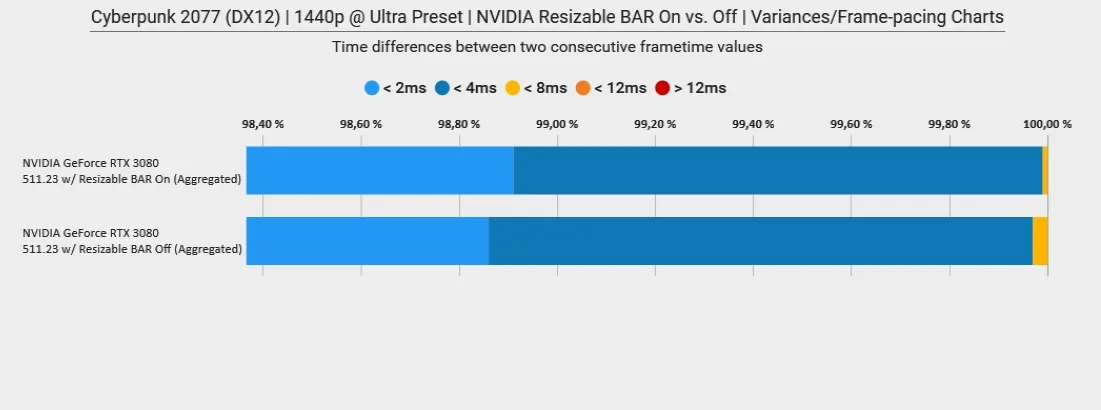 No significant performance differences were found between NVIDIA Resizable BAR on or off in Cyberpunk (DX12).
No significant performance differences were found between NVIDIA Resizable BAR on or off in Cyberpunk (DX12).
Cyberpunk 2077 (DXR) 

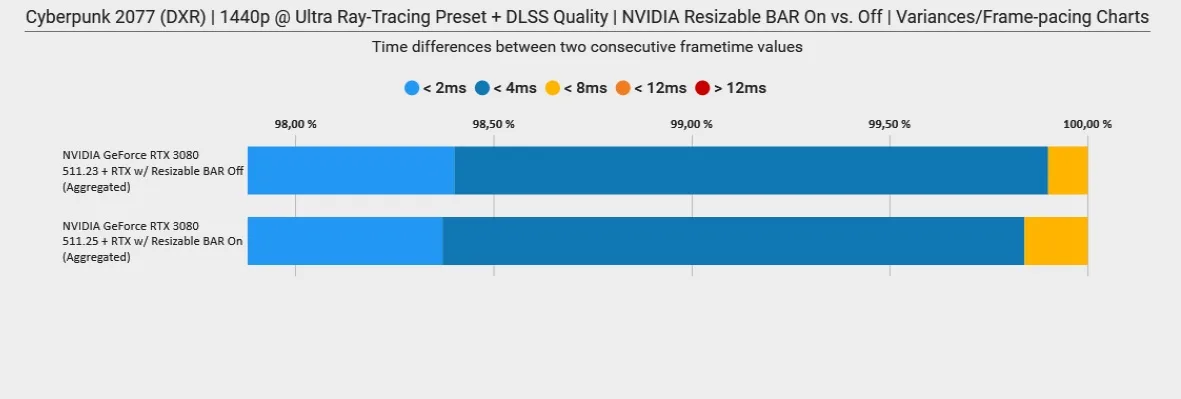
While we found a significant improvement in the average FPS with NVIDIA Resizable BAR enabled in Cyberpunk (RTX), frametime consistency and frame-pacing were similar.
DIRT 5 (DX12)
We see no significant differences in raw performance, frametime stability, and frame-pacing between NVIDIA Resizable BAR on or off in DIRT 5 (DX12). So here is another case of a technical tie.
DIRT 5 (DXR)

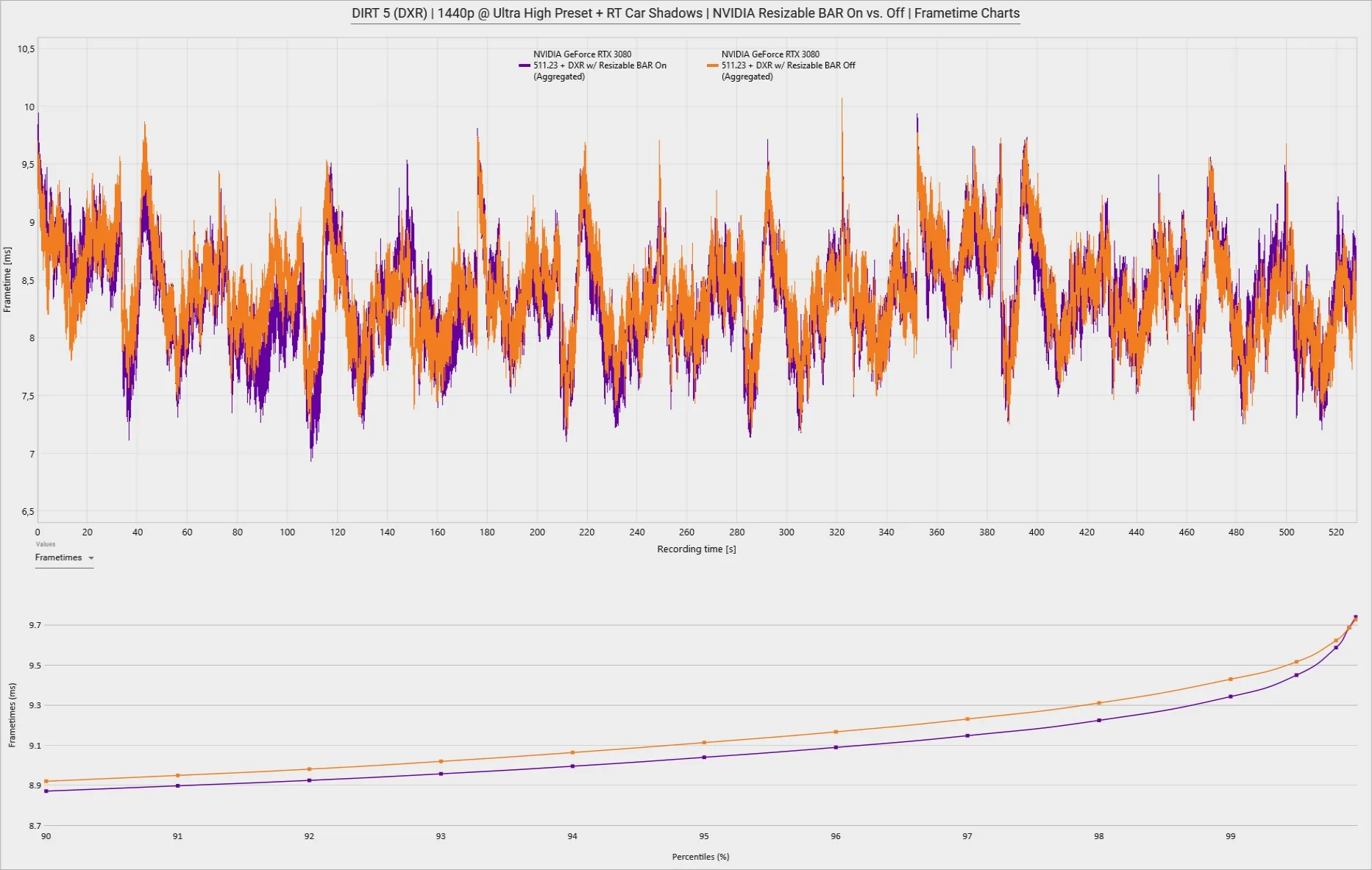
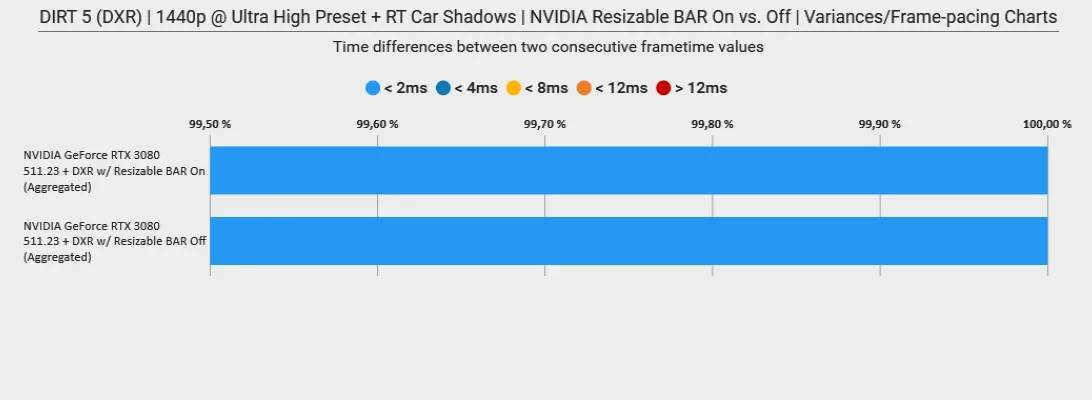 Again, we see no significant performance differences between having NVIDIA Resizable BAR enabled or disabled in DIRT (DXR).
Again, we see no significant performance differences between having NVIDIA Resizable BAR enabled or disabled in DIRT (DXR).
Hitman 3 (DX12)

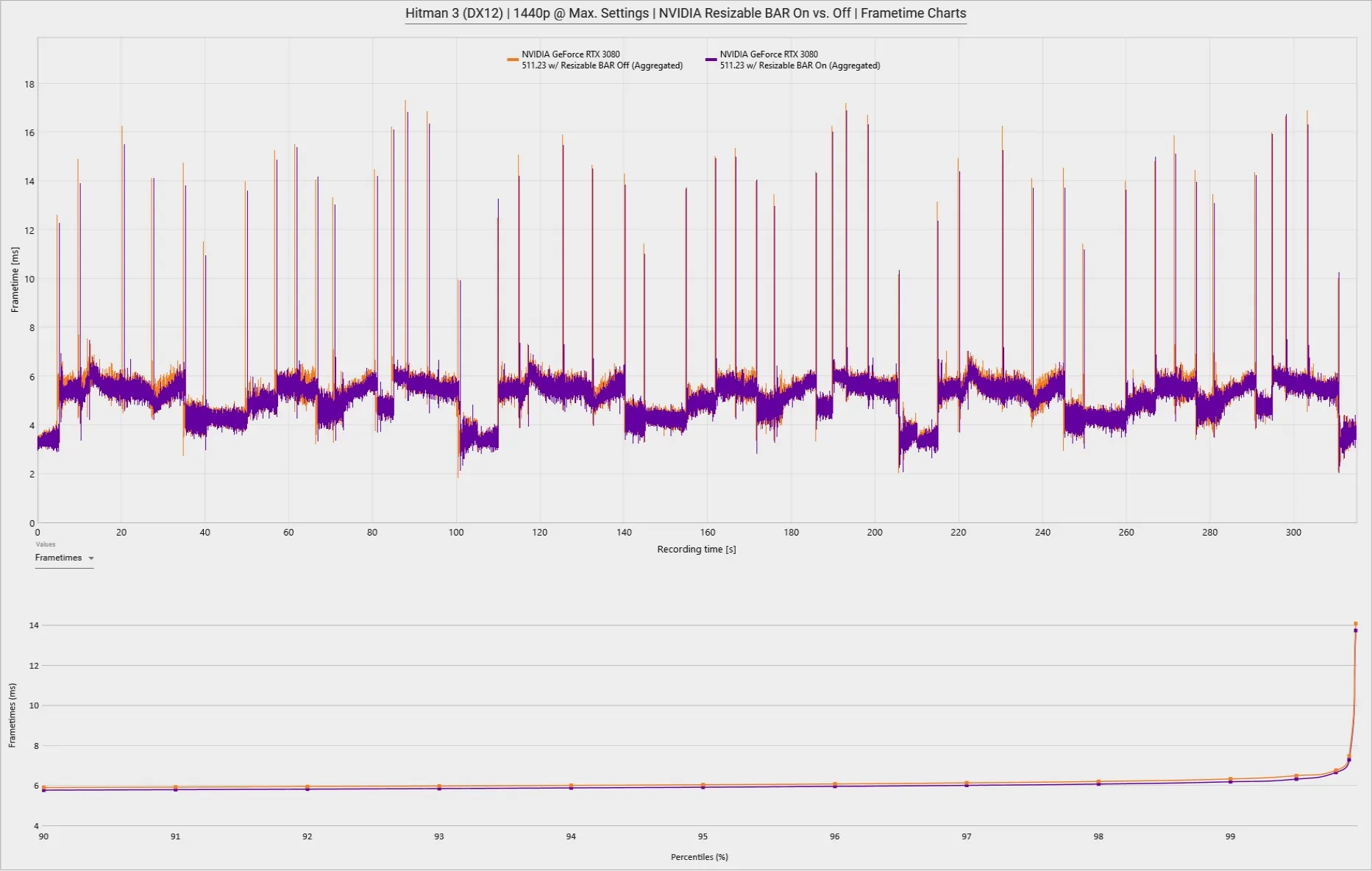
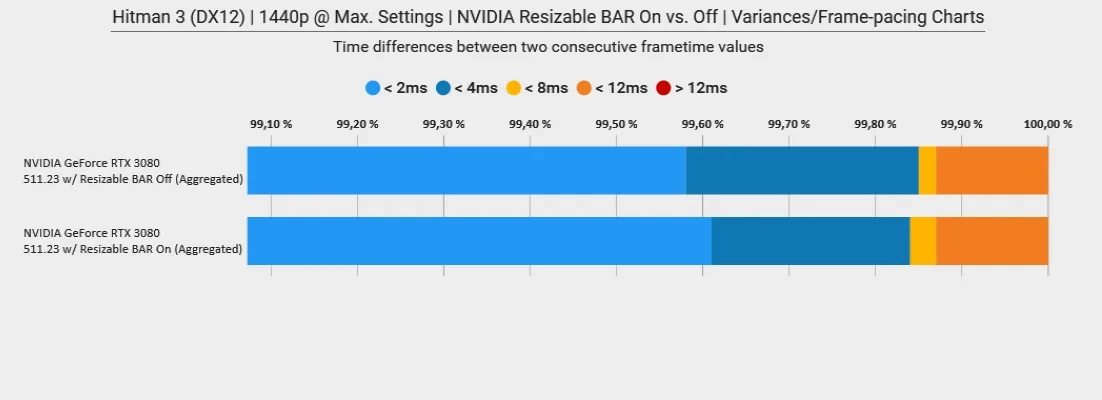 Although we see a slightly better average FPS with NVIDIA Resizable BAR enabled in Hitman 3 (DX12), performance is overall similar with this feature enabled or disabled.
Although we see a slightly better average FPS with NVIDIA Resizable BAR enabled in Hitman 3 (DX12), performance is overall similar with this feature enabled or disabled.
Horizon Zero Dawn (DX12)


 We see no significant differences. Horizon Zero Dawn (DX12) shows overall the same performance with NVIDIA Resizable BAR enabled or disabled.
We see no significant differences. Horizon Zero Dawn (DX12) shows overall the same performance with NVIDIA Resizable BAR enabled or disabled.
Metro Exodus (DX12)


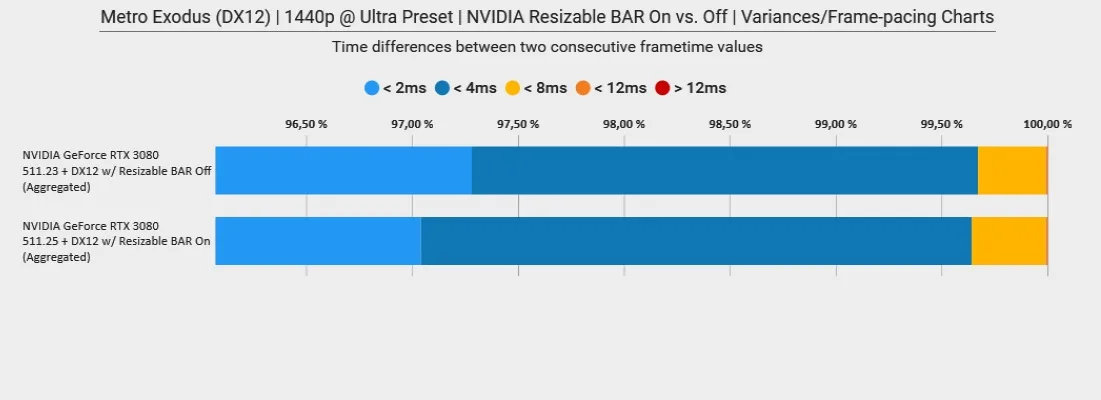 Again, this is a case of a technical tie in performance between having NVIDIA resizable BAR enabled or disabled.
Again, this is a case of a technical tie in performance between having NVIDIA resizable BAR enabled or disabled.
Metro Exodus (DXR)


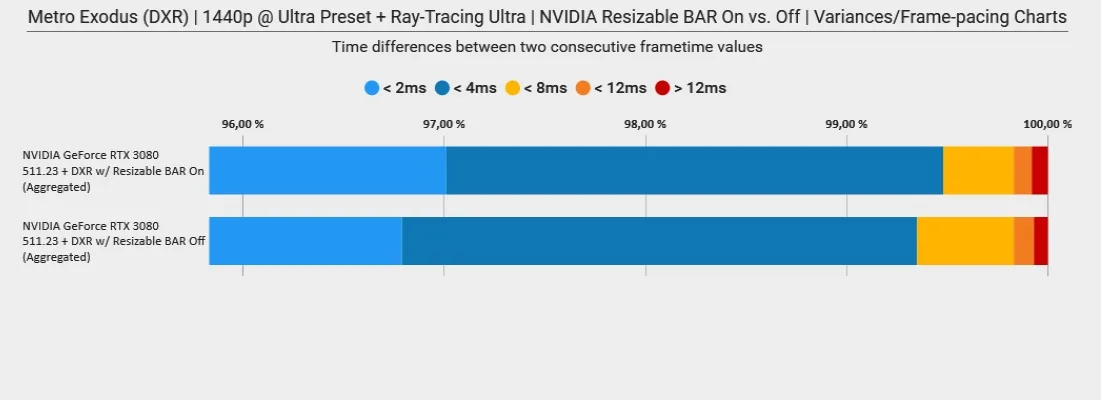 Metro Exodus (DXR) also shows a similar performance with NVIDIA Resizable BAR enabled or disabled. The differences were not significant.
Metro Exodus (DXR) also shows a similar performance with NVIDIA Resizable BAR enabled or disabled. The differences were not significant.
Metro Exodus PC Enhanced Edition (DX12)

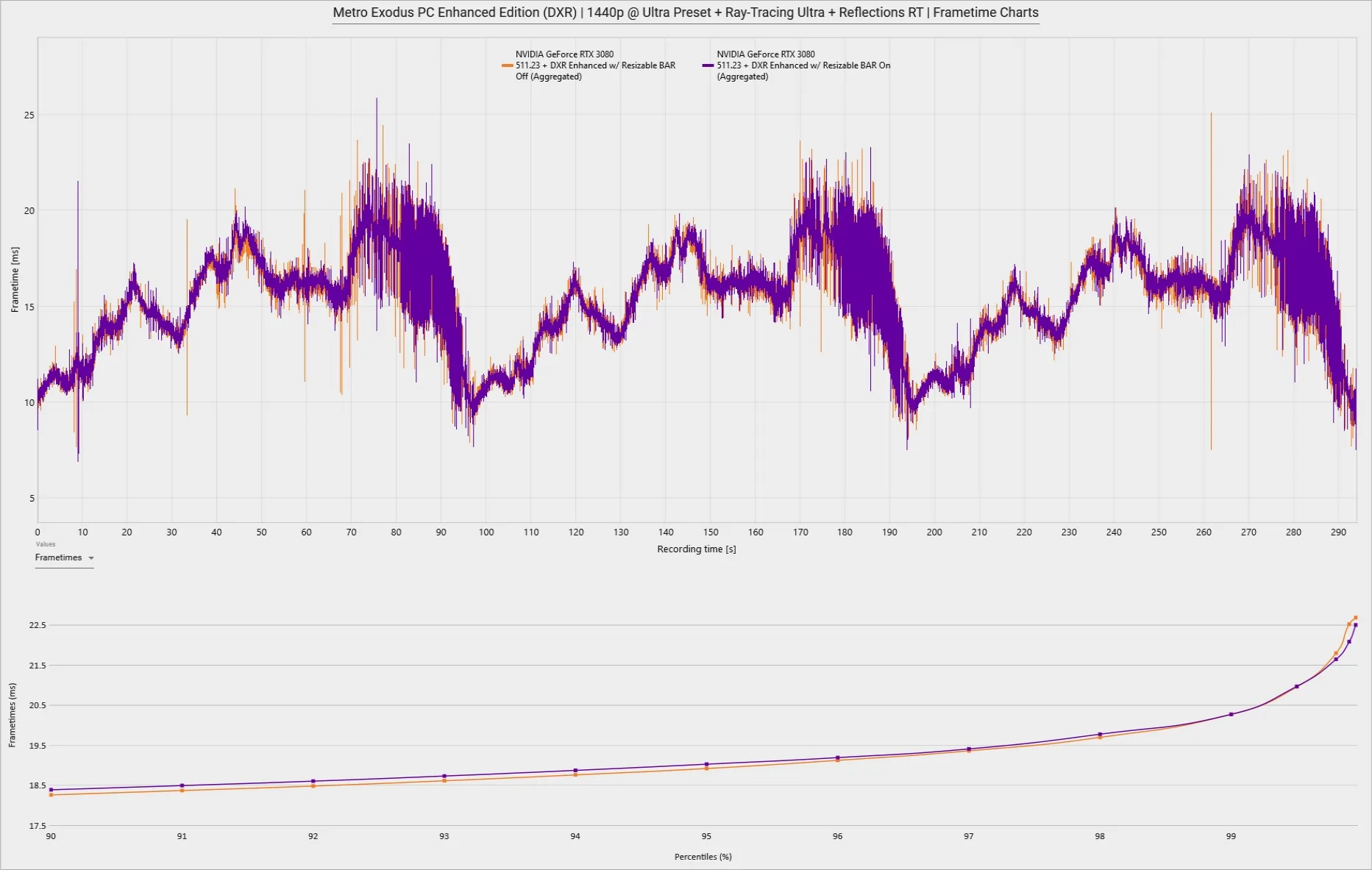
 Again, we found another case where the NVIDIA Resizable BAR feature state (on vs. off) doesn’t make any noteworthy performance difference.
Again, we found another case where the NVIDIA Resizable BAR feature state (on vs. off) doesn’t make any noteworthy performance difference.
Watch Dogs: Legion (DX12)
We don’t see significant performance differences with NVIDIA Resizable BAR enabled or disabled in Watch Dogs: Legion (DX12).
Watch Dogs: Legion (DXR)

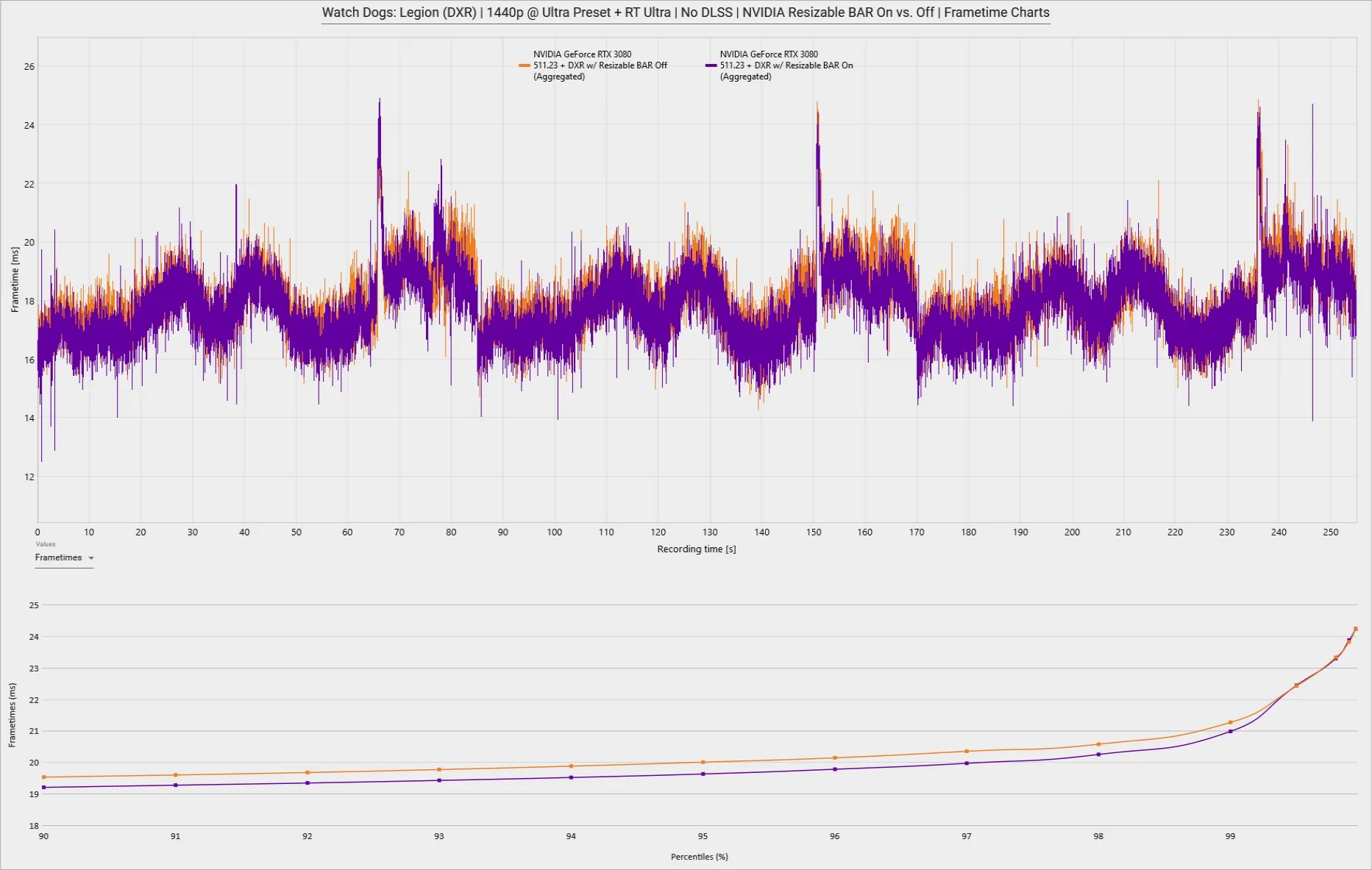
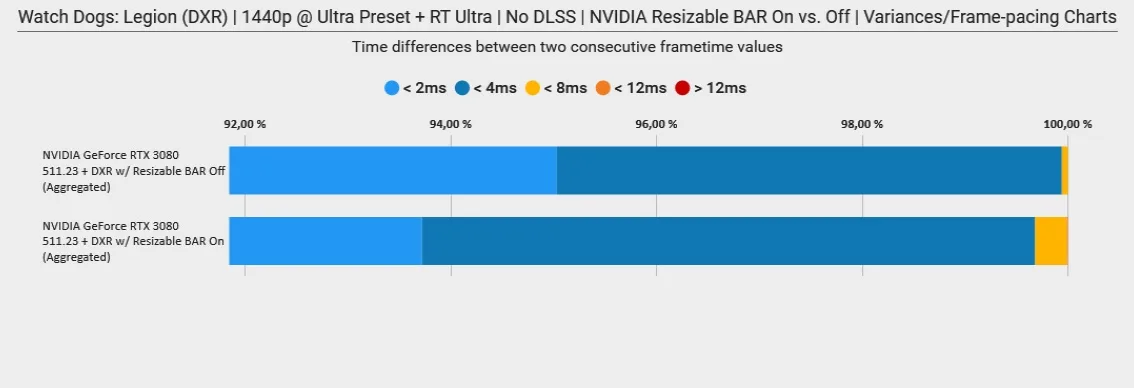 Finally, no significant differences in raw performance, frametime consistency, and frame-pacing were found between NVIDIA Resizable BAR on or off in Watch Dogs: legion (DXR).
Finally, no significant differences in raw performance, frametime consistency, and frame-pacing were found between NVIDIA Resizable BAR on or off in Watch Dogs: legion (DXR).
NVIDIA Resizable BAR Performance – Summary Chart
Here is the performance summary chart of the nine NVIDIA Resizable BAR compatible games we tested that are already part of our usual testing suite.

Notes on NVIDIA Resizable BAR Gaming Performance
For the game benchmarks, although we see significant improvements in raw performance in Assassin’s Creed Valhalla (DX12) and Cyberpunk 2077 (RTX), most games show no significant performance differences between having NVIDIA Resizable BAR enabled or disabled.
The best news is that we didn’t see any significant regression in raw performance, frametime stability, or frame-pacing with NVIDIA resizable BAR enabled using our officially supported Z690/12900K CPU platform. Also, our results support NVIDIA’s claims about the value of enabling Resizable BAR for their pre-tested games that showed a positive effect (either in the forms of improvements or lack of regressions).
Disclaimer
Please be aware that the following results, notes, and the corresponding NVIDIA Resizable BAR recommendations are valid for similar Ampere gaming rigs (with officially supported Z690 Intel motherboards) using GeForce Game Ready 511.23 driver and Windows 11 v21H2. Its representativeness, applicability, and usefulness on different testing benches, CPU platforms, GPU drivers, and MS Windows versions may vary.
Final Thoughts
Based on our results and findings, we recommend NVIDIA Resizable BAR’s general use for platforms similar to ours (Z690) and for those that have official support.
However, we cannot recommend the same for platforms that lack NVIDIA’s official support, like Z390 or older CPU platforms. If so, our recommendation would be to disable it globally or carry out your tests. If the whitelisted game installed on your system worsens its performance with Resizable BAR on, deactivate it on a per-game basis, as explained here.
Let’s play!
***
Rodrigo González (aka “RodroG”) is an enthusiast gamer and tech reviewer interested especially in shooter games, open-world role-playing games, and software and hardware benchmarking. He is the author of the NVIDIA WHQL Driver Performance Benchmarks Series and founder and moderator of the r/allbenchmarks community on Reddit.





